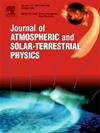气象变率对德里冬季雾期气溶胶粒径分布的影响:个案研究
IF 1.9
4区 地球科学
Q3 GEOCHEMISTRY & GEOPHYSICS
Journal of Atmospheric and Solar-Terrestrial Physics
Pub Date : 2025-04-30
DOI:10.1016/j.jastp.2025.106531
引用次数: 0
摘要
气溶胶的大小分布,特别是数量和质量分布,在理解吸湿性增长导致的光学性质变化方面起着至关重要的作用,而吸湿性增长会影响区域尺度上的能见度和辐射强迫。印度恒河平原(IGP),包括德里的国家首都地区(NCR),在季风后至冬季(10月至2月)每年都会经历严重的雾霾和能见度降低。本研究使用地面光学粒子计数器报告了德里冬季雾霾期间(2015年12月15日- 2016年2月15日)气溶胶质量大小的分布。在运动期间,细态和粗态气溶胶分别占总气溶胶质量浓度的85%和15%。研究了Vis-1 (<600 m)、Vis-2 (600 ~ 1200 m)和Vis-3 (>1200 m) 3种能见度条件下气溶胶粒径分布、有效半径的特征变化,以及气象因子特别是相对湿度(RH)和温度的影响。细模气溶胶占气溶胶总质量的约85%,与气溶胶有效半径最低(Reff: 0.44 μm)的Vis-3相比,在Vis-1和Vis-2期间,其浓度分别增加了3.7和2.3倍。细颗粒物浓度与相对湿度呈显著正相关(R = 0.35),与能见度呈显著负相关(R = - 0.65),表明高相对湿度和细态气溶胶有助于德里- ncr地区雾的形成和能见度的降低。本文章由计算机程序翻译,如有差异,请以英文原文为准。

Influence of meteorological variability on aerosol size distribution during the winter fog campaign over Delhi: a case study
The aerosol size distribution, particularly the number and mass distributions, plays a crucial role in understanding changes in optical properties due to hygroscopic growth, which affects visibility and radiative forcing on a regional scale. The Indo-Gangetic Plain (IGP), including National Capital Region (NCR) of Delhi, experiences severe fog and haze with reduced visibility during the post-monsoon to winter months (October–February) every year. This study reports aerosol mass size distribution over Delhi during a winter fog campaign (December 15, 2015–February 15, 2016) using a ground-based optical particle counter. The fine and coarse mode aerosols were contributed to ∼85% and 15% to the total aerosol mass concentration during the campaign period. The characteristic changes in aerosol size distribution, effective radius, and the influence of meteorological factors, particularly relative humidity (RH) and temperature, under three visibility conditions: Vis-1 (<600 m), Vis-2 (600–1200 m), and Vis-3 (>1200 m) were investigated. Fine-mode aerosols accounted for ∼85 % of the total aerosol mass, with their concentration increasing by a factor of 3.7 during Vis-1 and 2.3 during Vis-2 compared to Vis-3, when the effective radius of aerosol was lowest (Reff: 0.44 μm). Fine particle concentrations showed a positive correlation with RH (R = 0.35) and a negative correlation with visibility (R = −0.65), suggesting that the high RH and fine-mode aerosols contribute to fog formation and reduced visibility in Delhi-NCR.
求助全文
通过发布文献求助,成功后即可免费获取论文全文。
去求助
来源期刊

Journal of Atmospheric and Solar-Terrestrial Physics
地学-地球化学与地球物理
CiteScore
4.10
自引率
5.30%
发文量
95
审稿时长
6 months
期刊介绍:
The Journal of Atmospheric and Solar-Terrestrial Physics (JASTP) is an international journal concerned with the inter-disciplinary science of the Earth''s atmospheric and space environment, especially the highly varied and highly variable physical phenomena that occur in this natural laboratory and the processes that couple them.
The journal covers the physical processes operating in the troposphere, stratosphere, mesosphere, thermosphere, ionosphere, magnetosphere, the Sun, interplanetary medium, and heliosphere. Phenomena occurring in other "spheres", solar influences on climate, and supporting laboratory measurements are also considered. The journal deals especially with the coupling between the different regions.
Solar flares, coronal mass ejections, and other energetic events on the Sun create interesting and important perturbations in the near-Earth space environment. The physics of such "space weather" is central to the Journal of Atmospheric and Solar-Terrestrial Physics and the journal welcomes papers that lead in the direction of a predictive understanding of the coupled system. Regarding the upper atmosphere, the subjects of aeronomy, geomagnetism and geoelectricity, auroral phenomena, radio wave propagation, and plasma instabilities, are examples within the broad field of solar-terrestrial physics which emphasise the energy exchange between the solar wind, the magnetospheric and ionospheric plasmas, and the neutral gas. In the lower atmosphere, topics covered range from mesoscale to global scale dynamics, to atmospheric electricity, lightning and its effects, and to anthropogenic changes.
 求助内容:
求助内容: 应助结果提醒方式:
应助结果提醒方式:


